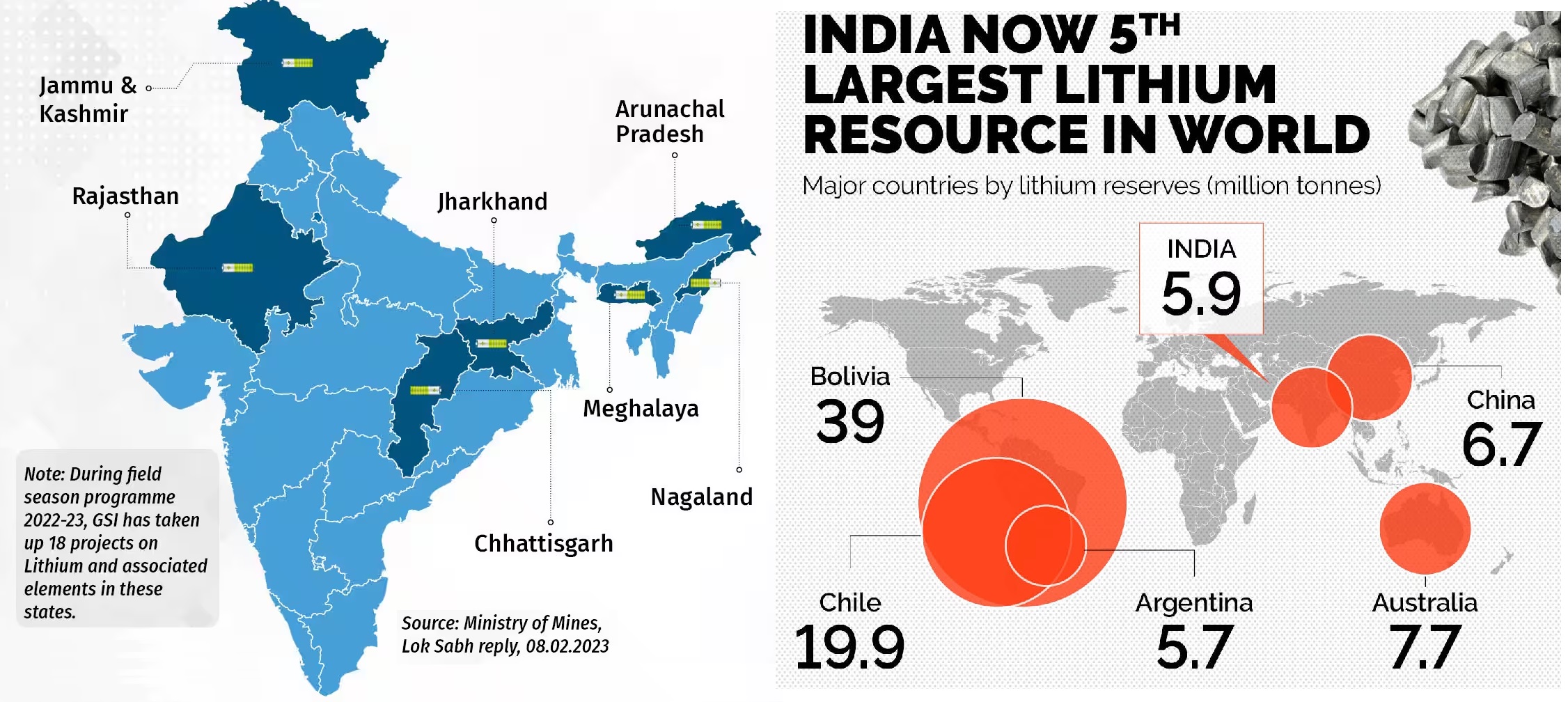India passes law allowing private firms to bid for and mine lithium
Context
To increase the mining of the essential component for EV batteries, the Indian Parliament passed a law allowing the government to auction and mine its recently discovered lithium reserves, among other minerals.
What is the latest law passed in favour of Mining?
- Law Passed: A law has been passed by the Indian Parliament allowing the government to mine and auction off recently discovered reserves of vital minerals like lithium, titanium, beryl, niobium, and zirconium.
- Removed from Atomic Minerals List: Lithium and other minerals must be removed from the list of atomic minerals by the law. These minerals were previously solely accessible to state-run enterprises since they were classified as atomic minerals.
- Private Sector Participation: With these minerals being taken off the list of atomic minerals, the private sector will now be able to explore and extract these resources. This action is anticipated to entice private enterprises to contribute to and invest in mining operations.
- New Lithium Reserves: India has benefited greatly from the discovery of lithium reserves in Jammu and Kashmir earlier this year. It gives the nation the chance to use its native lithium resources, lowering dependency on imports and boosting energy security.
What are the uses of these elements in application?
Lithium:
- Batteries: Due to their high energy density and long lifespan, lithium-ion batteries are widely utilized in a variety of electronic products, including smartphones, laptops, tablets, and electric vehicles (EVs).
- aircraft: Lithium is utilized in some types of nuclear reactors as a coolant and for lightweight components in aircraft applications.
- Pharmaceuticals: Bipolar illness and other mental health issues are treated with drugs containing lithium molecules.
- Ceramics and Glass: Lithium compounds are used in the production of ceramics and glass due to their distinctive characteristics.
Titanium:
- Aerospace: Titanium is utilized extensively in the aerospace sector because of its high strength-to-weight ratio, resistance to corrosion, and heat resistance. It is utilized in spacecraft, engines, and parts of aeroplanes.
- Medical implants: Titanium’s biocompatibility makes it appropriate for implants used in dentistry and joint replacement.
- Chemical Processing: Due to its resistance to chemical corrosion, titanium equipment is employed in the chemical processing sector.
Beryl:
- Gemstones: Beryl variations that are utilized in jewellery as precious gemstones include emerald and aquamarine.
- Industrial Use: Beryl is a source of beryllium, which is used in nuclear reactors, the aerospace industry, and other high-tech fields.
How is this mining going to be useful for India?
- Electric Vehicle (EV) Industry: India’s efforts to mine and use lithium can considerably aid the expansion of the electric vehicle (EV) sector. Because lithium is a key component of EV batteries, India’s customers may find EVs more accessible and affordable if domestic reserves help lessen the country’s reliance on imports and slash battery prices. This can support efforts to tackle climate change on a global scale by lowering air pollution, enhancing energy security, and aligning with those efforts.
- Energy Storage Solutions: Effective energy storage solutions are essential given India’s growing usage of renewable energy. The power system can be stabilized and excess renewable energy can be stored with the help of lithium-ion batteries. Large-scale energy storage projects may be deployed more easily with access to indigenous lithium sources, improving grid stability and renewable energy integration.
- Aerospace and Defence: Titanium is valuable for aerospace and defence applications because of its strength, low weight, and corrosion resistance. Utilizing native titanium resources can help India’s aerospace industry, especially the production of aircraft parts and the improvement of the Indian Armed Forces’ capabilities.
- Industrial Development: Beryl, niobium, and zirconium have a variety of industrial uses, including chemical processing, superconductors, and steel alloying. The availability of these minerals domestically can stimulate several industries, fostering domestic production, exports, and economic expansion.
- Energy Security: India can lessen its dependency on imports from other nations by creating domestic sources of essential minerals like lithium. This improves energy security and lessens vulnerability to market and supply chain disturbances.
What issues are there with mining these elements in India?
- Environmental Impact: Mining operations have the potential to seriously harm the environment, notably through deforestation, habitat loss, soil erosion, and water contamination. To reduce these effects and guarantee ethical mining methods, appropriate environmental safeguards and laws must be in place.
- Water Use and Contamination: For processing and extraction, mining operations frequently need a lot of water. Water shortage in the area and a negative impact on the ecosystem might result from excessive water use. Additionally, mining operations have the potential to leak dangerous chemicals and heavy metals into waterways, contaminating the water and endangering the health of communities downstream.
- Land Use and Displacement: Mining projects may necessitate extensive land acquisition, which could result in the relocation of local communities and the loss of sources of income for native and rural populations. To address these social and economic repercussions, appropriate compensation and resettlement measures must be put in place.
- Deforestation and biodiversity loss: Forest areas may be removed to make room for mining operations, which can result in deforestation and a loss of biodiversity. This could hurt local species, disturb ecosystems, and impair native flora and fauna.
- Safety hazards: Accidents and safety risks can occur during mining operations, putting workers’ health and safety at risk. To ensure the safety of persons engaged in mining activities, adequate safety measures and worker protections should be in place.





